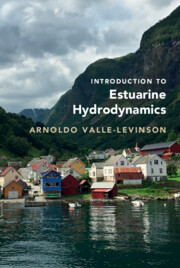Book contents
- Introduction to Estuarine Hydrodynamics
- Introduction to Estuarine Hydrodynamics
- Copyright page
- Contents
- Preface
- 1 Introduction and Classification
- 2 Conservation Equations
- 3 Tides in Semienclosed Basins
- 4 Shallow-Water Tides
- 5 Tidal Residual Flows in Homogeneous, Semienclosed Basins
- 6 Wind-Driven Flows in Homogeneous, Semienclosed Basins
- 7 Flows Driven by Density Gradients
- 8 Interactions among Tides, Density Gradients, and Wind
- 9 Fronts
- 10 Time Scales in Semienclosed Basins
- 11 Semienclosed Basins with Low or No Discharge
- 12 Classification of Semienclosed Basins, Based on Dynamics
- Index
- References
3 - Tides in Semienclosed Basins
Published online by Cambridge University Press: 24 February 2022
- Introduction to Estuarine Hydrodynamics
- Introduction to Estuarine Hydrodynamics
- Copyright page
- Contents
- Preface
- 1 Introduction and Classification
- 2 Conservation Equations
- 3 Tides in Semienclosed Basins
- 4 Shallow-Water Tides
- 5 Tidal Residual Flows in Homogeneous, Semienclosed Basins
- 6 Wind-Driven Flows in Homogeneous, Semienclosed Basins
- 7 Flows Driven by Density Gradients
- 8 Interactions among Tides, Density Gradients, and Wind
- 9 Fronts
- 10 Time Scales in Semienclosed Basins
- 11 Semienclosed Basins with Low or No Discharge
- 12 Classification of Semienclosed Basins, Based on Dynamics
- Index
- References
Summary
This chapter covers basic concepts on the forces that drive tides. It presents a description of the main harmonics or constituents related to the driving forces, followed by a presentation of the concept of spring and neap tides, as well as their analogous tropic and equatorial tides. It then introduces the fundamental physics for a frictionless tidal wave, while depicting progressive and standing waves. It continues with the conditions for tidal resonance. The chapter then includes the effects of bottom friction on tidal currents and covers the effects of convergent coastlines by presenting the concepts of hypersynchronic, hyposynchronic, and synchronic basins. It follows with the effects of Earth’s rotation on frictionless tides and the generation of amphidromic points. The chapter goes further with an exploration of the effects of lateral bathymetry on tidal flows.
Keywords
- Type
- Chapter
- Information
- Introduction to Estuarine Hydrodynamics , pp. 27 - 50Publisher: Cambridge University PressPrint publication year: 2022

